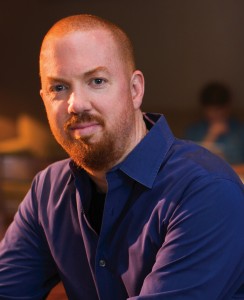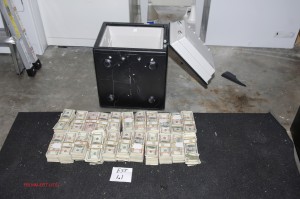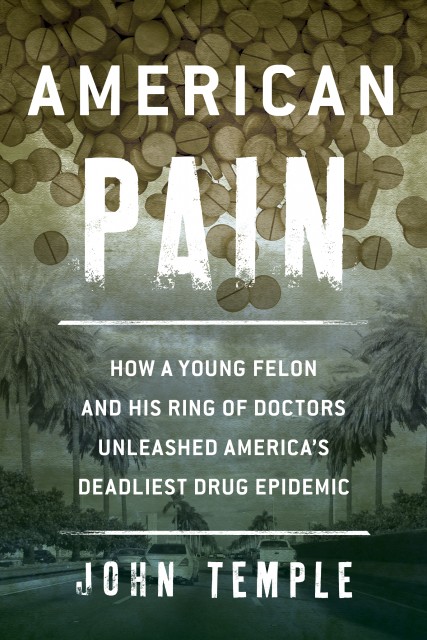Twin brothers Chris and Jeff George, took advantage of loopholes in the law to open a pain clinic in Florida, American Pain, that turned into a multimillion dollar enterprise that stretched up I75, otherwise known as Oxy Alley, supplying Oxycontin. The legalized racket made the brothers rich and created a whole new sub industry in the drug trade hierarchy centering on what became known as Hillbilly Heroin. Oxyxotin was a legal pain killer produced by American pharmaceutical companies with scheduling quotas set by the Drug Enforcement Agency each year.
Purdue Pharma developed the drug in the mid-90s and its use grew to epic proportions spawning lawsuits as rural communities in states like Kentucky and West Virginia were laid waste by the drug. As Hillbilly Heroin took the rural areas of America by storm in the mid-to-late 2000s by way of pill mills, a college professor at West Virginia University in Morgantown, was witnessing the affects of the Oxy epidemic first hand.
In his new book, American Pain: How a Young Felon and His Ring of Doctors Unleashed America’s Deadliest Drug Epidemic, Temple chronicles the story of how the two brothers, with zero medical experience, built a pill empire that was run like a criminal organization, employing tattooed work out nuts for security, strippers as nurses and receptionists and doctors who created bogus medial files and wrote scripts for the doses of oxycontin all day long. It was a legalized retail drug outlet and market, complete with junkies, enforcers and drug dealers.
The clinic only dealt in cash and stuffed the bills in trash cans, collecting upwards of several hundred thousand dollars a day. Addicts would be lined up around the block to get their legal fix daily. This is a story that reads like a cross between Breaking Bad and Justified. A legalized racket that made the brothers reach. But eventually the feds moved in and shut the operation down. We sat down for a chat with John Temple to get the specifics of the story.
 How did you get involved in the American Pain project?
How did you get involved in the American Pain project?
For years, I’ve been witnessing the devastation of these drugs in West Virginia and everywhere else. Students of mine tell me they are fighting painkiller addictions. Friends tell me about about relatives who can¹t kick pills. And I wondered where it all came from, because 20 years ago pills weren’t a big street drug. Then, when I read about a 27-year-old drug felon who¹d hired a bunch of doctors and built the biggest pill mill in the country, I knew I had a way to tell the story of American Pain.
Where are Chris and Jeff George now?
They¹re both in federal prison serving long sentences, but coincidentally, at this moment, Jeff is testifying in a state murder trial in Florida against a doctor who worked for him. The case involves a patient of theirs who died back in 2009, one of many. Depending on how the trial goes, it may be the first time a doctor has been found guilty of first-degree murder in a painkiller overdose case.
Your book reads like a cross between Breaking Bad and Justified, was that your intent?
I¹m a huge fan of both shows, especially Breaking Bad, so that¹s a gratifying comparison. Yeah, the arc of the story resembles Breaking Bad, and the fact that it takes place not only in Florida but also in Kentucky, where a lot of the pills landed, gives it a Justified feel. Justified was based on a short story by the late Elmore Leonard, and I thought a lot about his crime novels when I was writing the book, the street characters, the bad decisions, the only-in-Florida vibe.
How did an operation like this ever get off the ground?
Yeah, it¹s crazy. The funny part is, the guys who started American Pain, Chris George and his sidekick Derik Nolan, didn’t really expect it to take off either. They had no idea what they were getting into, and they were expecting to get shut down any day. But there was little that local law enforcement could do, because the basic transaction was legal, a doctor prescribing drugs to patients complaining of pain. So it took a federal investigation involving hundreds of people for more than a year to get American Pain shut down.
 Describe what was going on when the operation was at its height?
Describe what was going on when the operation was at its height?
Bizarre, bizarre world. Doctors carrying guns underneath their lab coats. Patients fishing out in the waiting room, meaning going into seizures. People giving blowjobs for pills in the parking lot. Millions of dollars in cash just lying around in piles. And everyone pretending like American Pain was a real doctor¹s office, because it was dangerous to act otherwise.
Would you say Chris and George are responsible for the Oxy epidemic?
Well, there were and are thousands of individuals and companies who happily made tons of money off of this epidemic. Certain pharmaceutical companies set the stage by lying to everyone for years about these drugs, saying that very few patients get addicted to them. And the DEA allowed it to happen by allowing the pharmaceutical companies to increase the amount of these drugs that are produced every year. (The DEA sets controlled substance manufacturing quotas every year, and we produce approximately 40 times the amount of oxycodone that we did in 1993.) What Chris George did was he realized that he could hire multiple doctors and rake in cash, he sort of Walmart-ized the pill mill concept, made it bigger and more efficient. And once people saw how much money American Pain was making, hundreds of shady operators followed in his wake. And that did fuel many thousands of addictions. So he definitely shoulders part of the blame.
The operation they were running was so much like an illegal drug operation how did they get away with it?
Because they took certain precautions, such as making sure each patient had a medical file, by requiring patients to get an MRI, by trying to not openly discuss the fact that their patients were mostly junkies. Eventually, Chris put American Pain in other people¹s names and they developed various rules, and it worked for awhile.
 What is the aftermath of the Oxy epidemic?
What is the aftermath of the Oxy epidemic?
It created thousands of addictions, and those don¹t just disappear because the drugs are harder to get. So as pill mills have been shut down and pills are harder to get, the street price of pills has risen. So people have turned to heroin. It¹s made from the same plant as oxycodone, and it produces the same fix, and it leads to the same addiction. People tend to demonize heroin, but it¹s essentially the same thing as oxycodone, not necessarily a harder drug. Heroin has two main differences, it¹s illegal and you don¹t know what¹s in it or how strong it is, so it is more dangerous in those respects. But the basic drug is the same.
How did they set up the pill mill in Florida?
A doctor clued them into the whole thing, taught them the business. They just found a little storefront, fixed it up, and opened up shop. But American Pain grew so fast that they kept having to move, local cops would harass the patients and neighbors would get upset. They kept moving from place to place.
Why did you decide to write this book?
It¹s a story that needed to be told, and nobody else was doing it. I tried not to write it for a few months after finding out about it, but it nagged at me, and finally I jumped in. And it¹s been a wild ride. Everyone involved with American Pain wanted to tell their story, the guys who built the clinic, the FBI agents who took it down, the mothers of people who died after going there. They all knew they¹d witnessed something extraordinary.
If you like this check out The Lufthansa Heist excerpt here.



